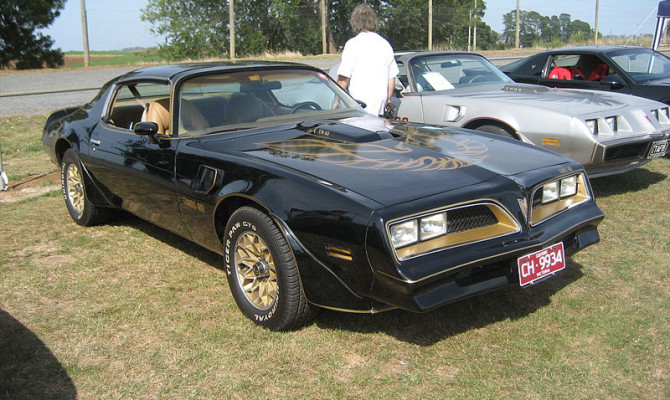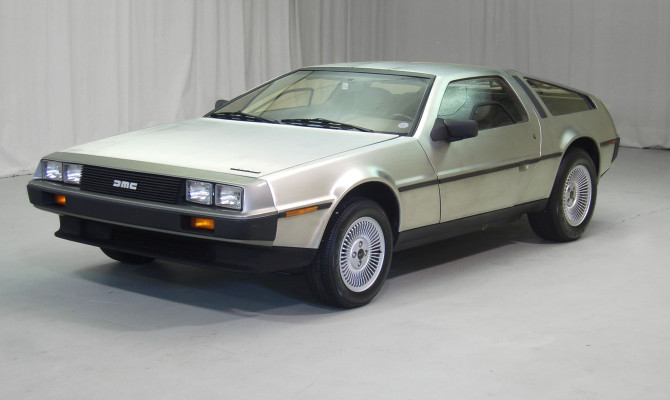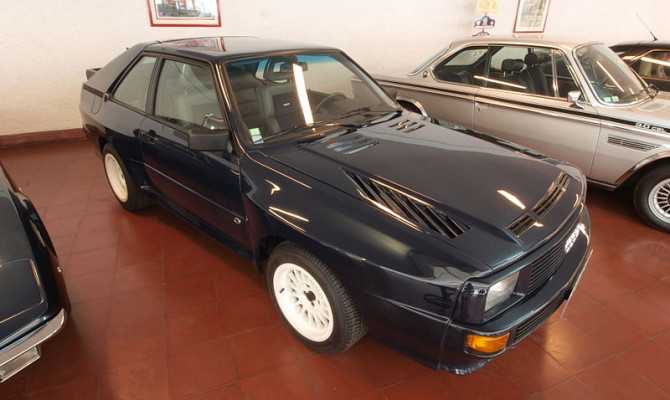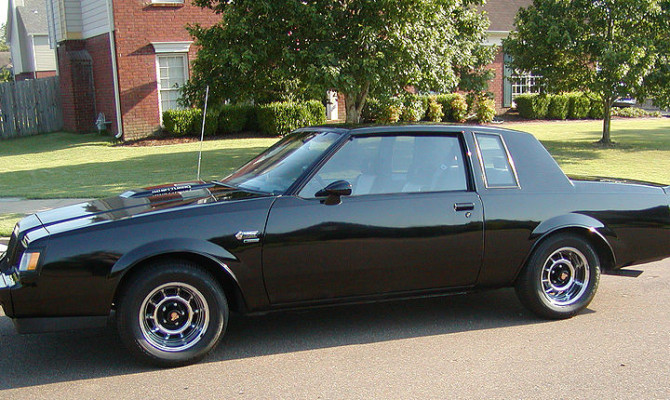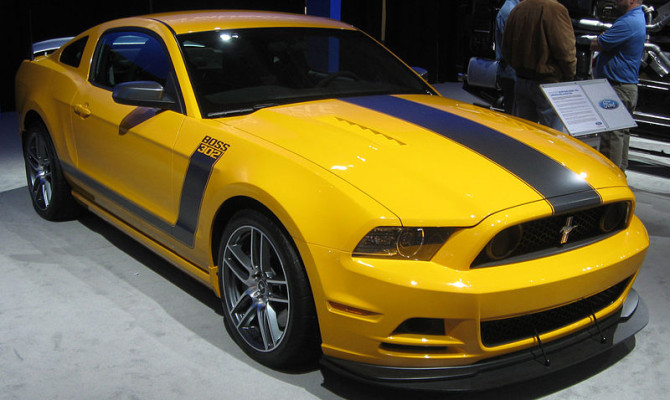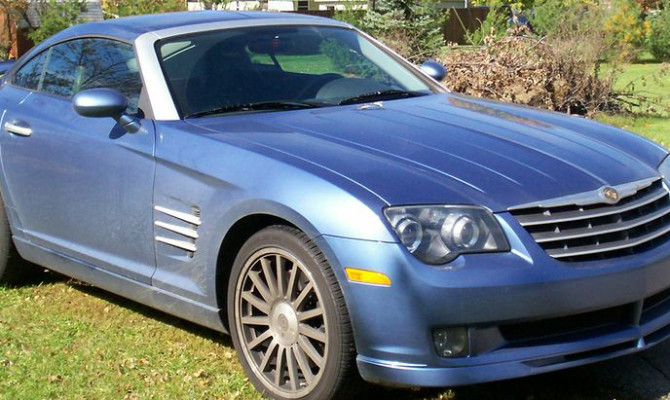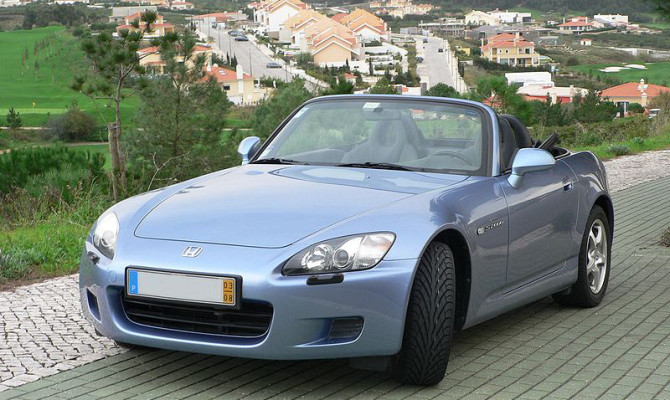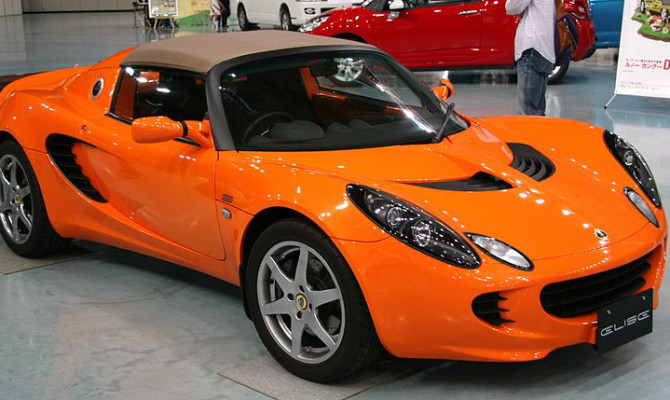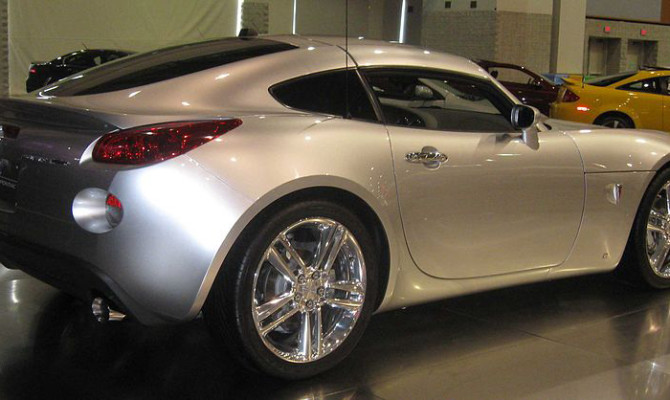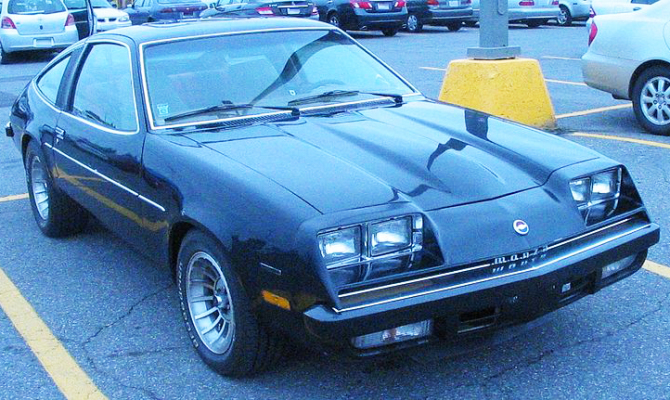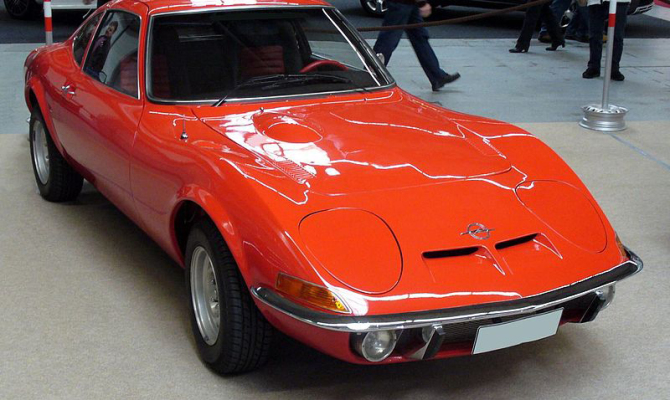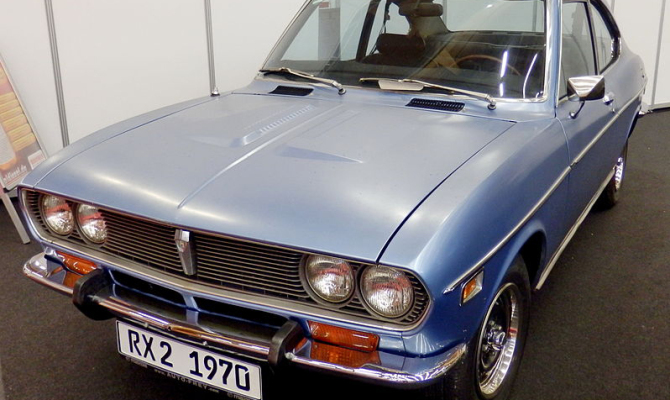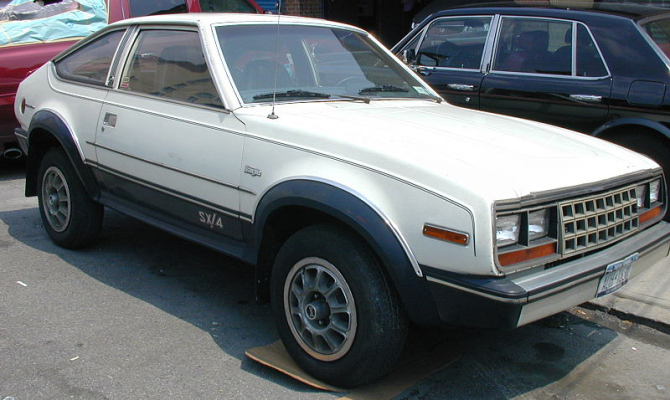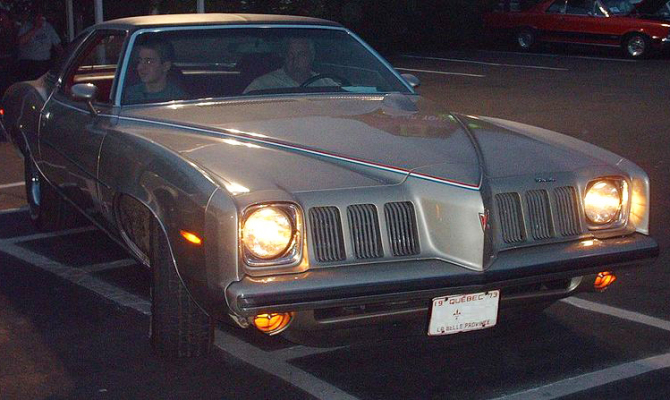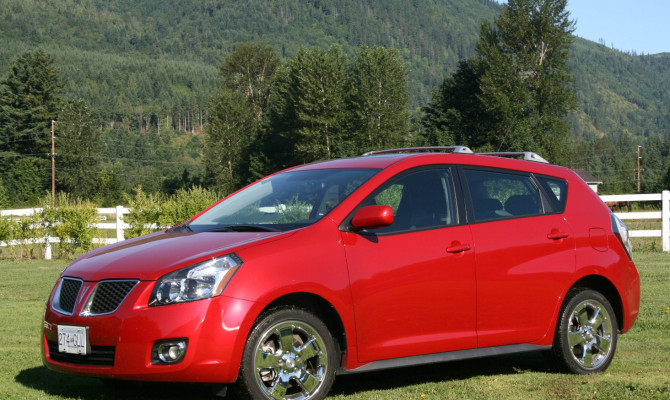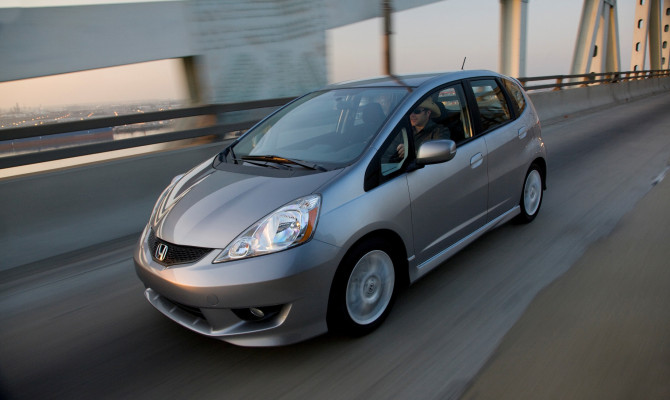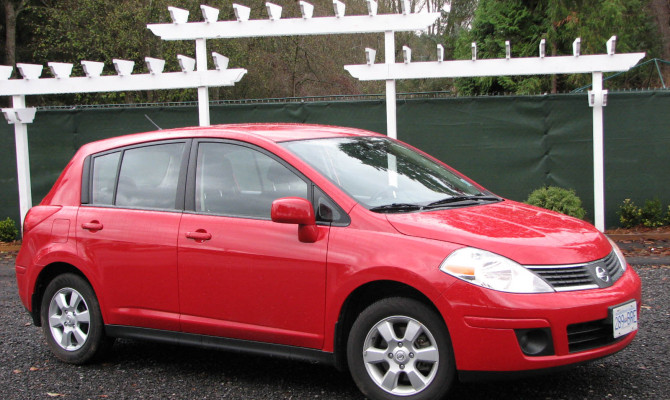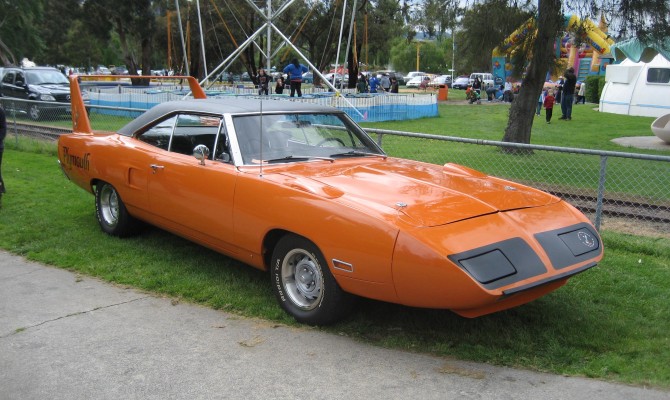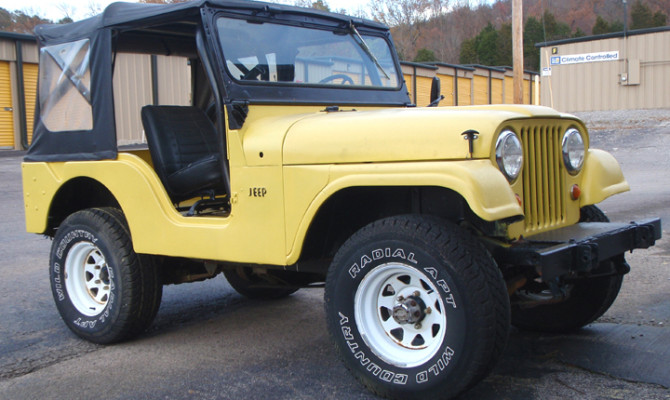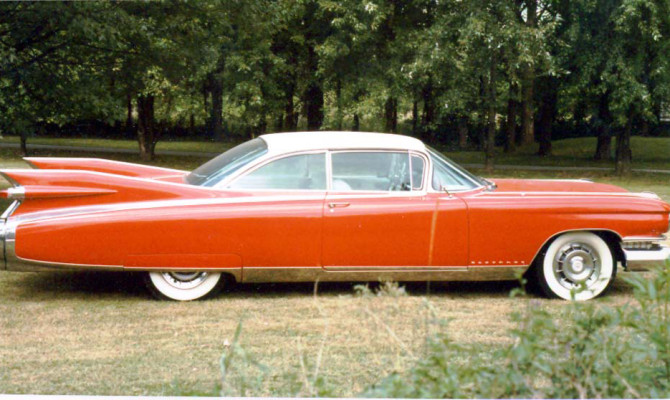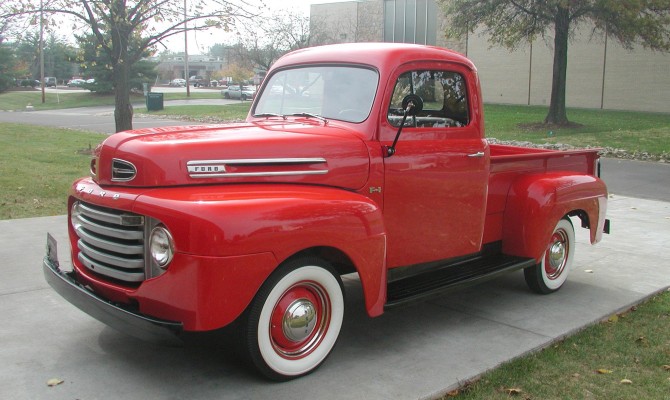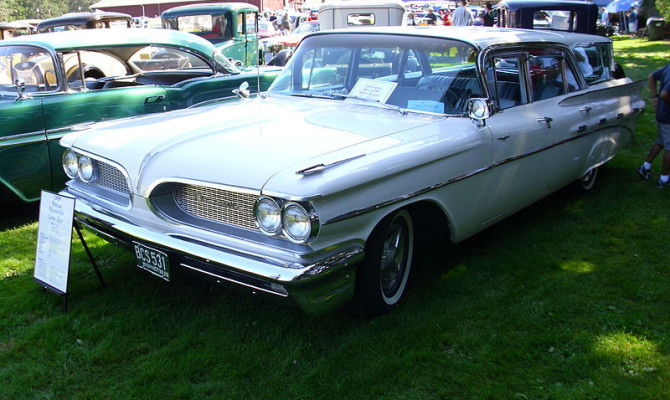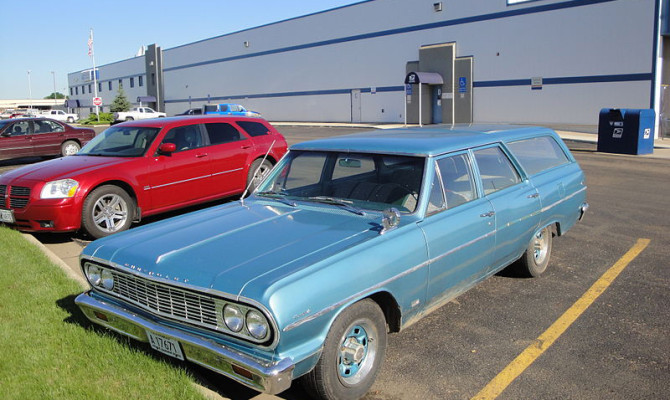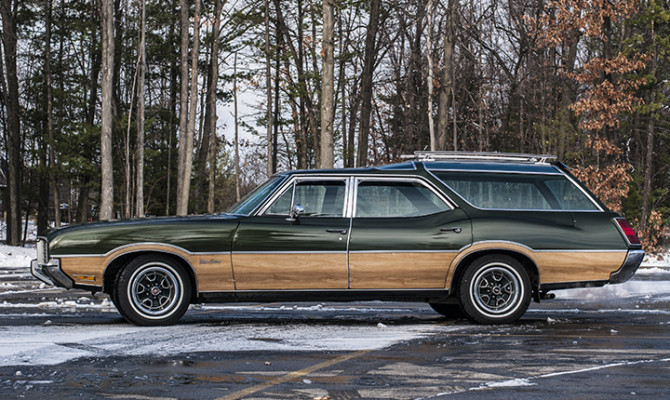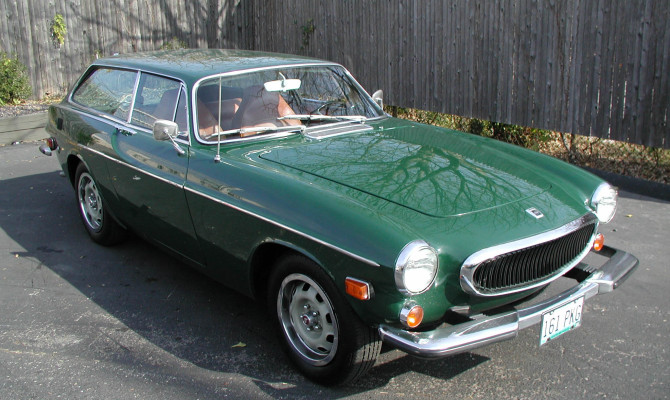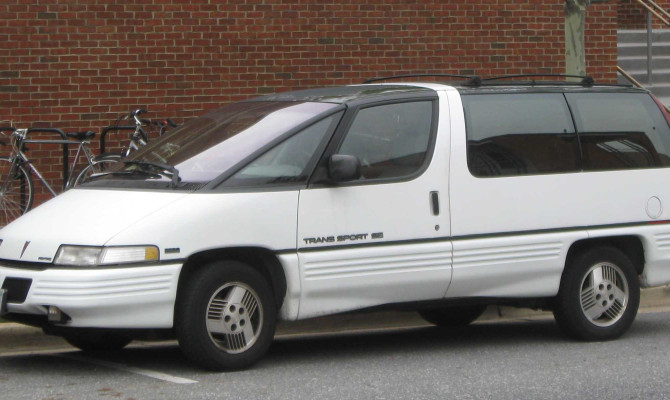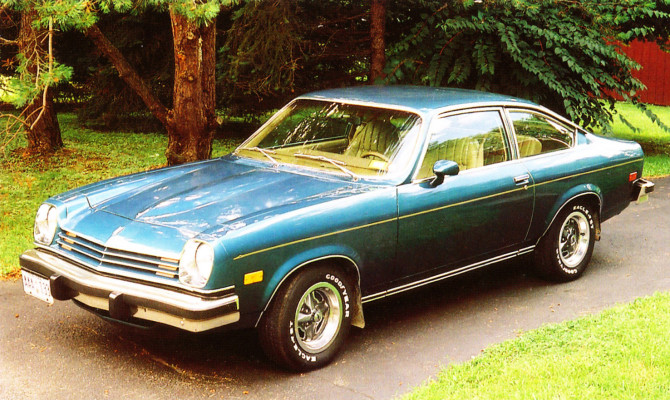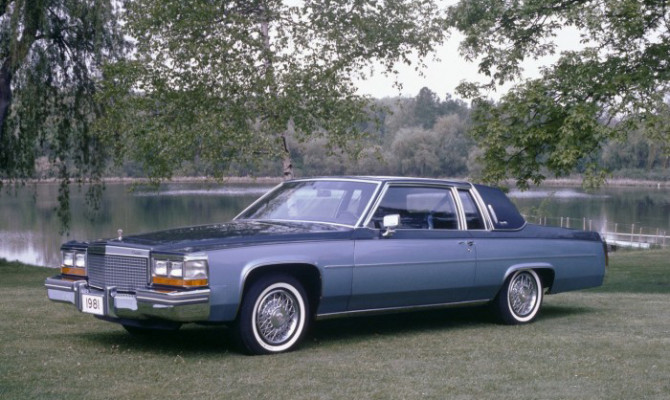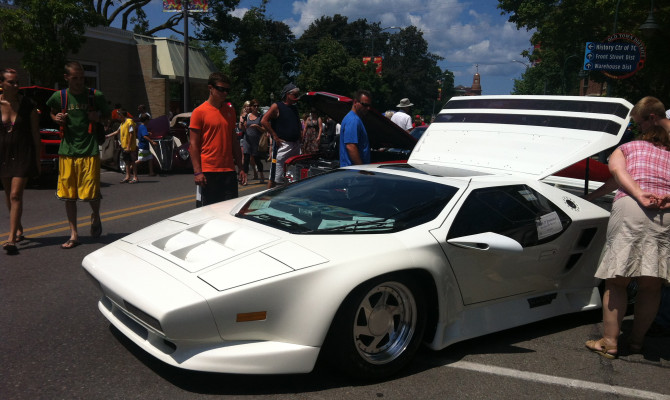by Grant Stoecker
The ‘Malaise Era’ was the antithesis of the muscle car heyday that existed merely a year before its start in 1973.
It was a dark period characterized best by underwhelming engines, EPA restrictions, and questionable styling. In the Malaise Era you could run your new Cobra through the gears without raising the attention of local law enforcement. The Malaise era wasn’t without hope, and the era saw production of a few diamonds in the rough. Here are our picks.
1. 1977 Pontiac Firebird Trans-Am Special Edition
Call it the Burt Reynolds Effect, but the 1977 Trans-Am is still a kick-ass ride. Featured in 1977’s top grossing film, Smokey and the Bandit, the black and gold Trans-Am had as much star power as the moustachioed Reynolds.
The power for the T/A came from a 6.6 litre V8, producing a disappointing 200 horses for 1977, a far cry years prior. It didn’t seem to matter as you cruised down main street, however, T-Tops in the trunk and blasting Journey through the 8-track. The menacing looks of the Trans Am seemed to be more than supple to erase any memory of the days of muscle car past, as other drivers stared in awe from the seats of the latest econo-box.
2. 1981-83 DeLorean DMC-12
The DMC-12 was the car from the future that no one had asked for, but everyone wanted.
Built by an automotive dream team consisting of John DeLorean, Colin Chapman, and Giorgetto Giugiaro, the DMC-12 was built to be a futuristic luxury coupe with a 200 horsepower Wankel rotary engine and price of $12,000. Execution of the concept missed the mark, and the production DMC-12 drew its underwhelming 130 horsepower from a Renault 6, and was sold for $36,000.
Despite this, the DeLorean secured its spot in the hearts of people around the globe as Doc Brown’s time machine in the 80’s mega-franchise, Back to the Future. If only they had come stock with the flux capacitor.
3. 1983-86 Audi Quattro
Germany continued to make fast cars throughout the malaise era, such as the BMW M1 and Porsche 930, but Audi created a completely new segment of car with the introduction of its all-wheel drive performance car, the Audi Quattro.
The Quattro was originally introduced to the European marketplace in 1980, but did not make its way stateside until 1983. With power from its turbocharged five-cylinder going to all four wheels, the Audi Quattro became a rally car legend, and the production models looked the part with its noticeable fender flares, Audi graphics, and BBS alloy wheels. The car was a head of its time, and only 664 were ever sold in the US before Audi discontinued it stateside in 1987.
4. 1974-76 Bricklin SV-1
Canada’s primary contribution to the malaise era was the brainchild of American millionaire Malcolm Bricklin, who dreamt of making the world’s safest sport car, naming his creation the Safety Vehicle One, or SV-1. The SV-1 had a smattering of safety features ranging from an integrated roll cage to safety bumpers, and even lacked an ashtray to discourage drivers from smoking. The Bricklin was powered by an AMC or Ford V8, and was rated favorably at the time against its competitor, the Corvette. Despite initial reviews, the car was notorious for poor build quality, and the engine was prone to overheating due to its small radiator. Bricklin went into receivership in 1976, and the SV-1 was dead in the water.
5. 1987 Buick Grand National/GNX
The Buick Grand National was not your grandfather’s Buick. Often referred to as Darth Vader’s car due to its all black paint scheme, the Buick Grand National was powered by a Turbocharged V6, and was rated for only 245 horsepower. The Grand National Experimental, or GNX, was the baddest of the Grand Nationals, and after rolling off the production line, it was sent to the mad scientists over at McLaren Performance, who modified the engine to be able to run 0 to 100 m/h in a mere 4.3 seconds, a figure impressive by modern standards.
Grant Stoecker writes for Hagerty Insurance. Hagerty is the world’s leading specialist provider of classic car and boat insurance. Learn more at hagerty.ca
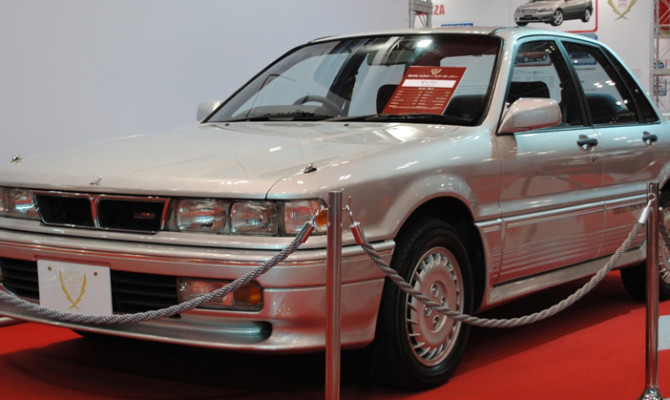
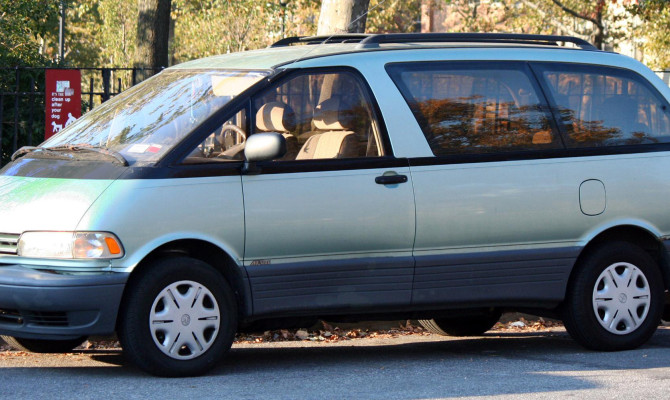
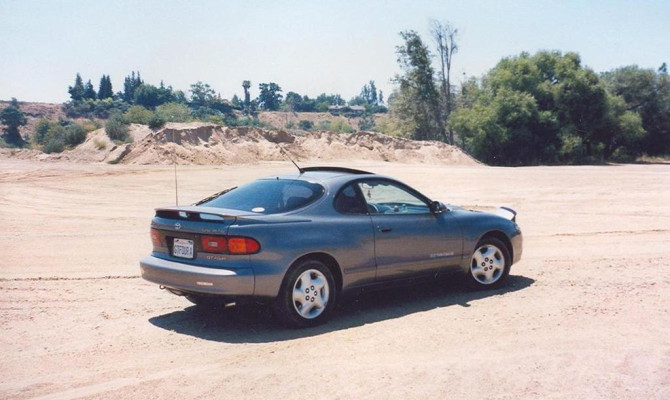
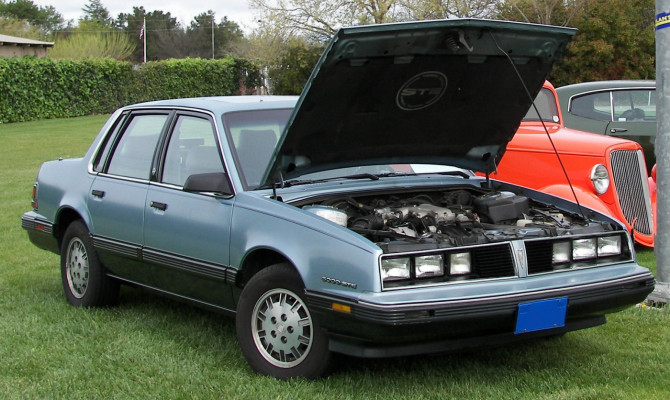
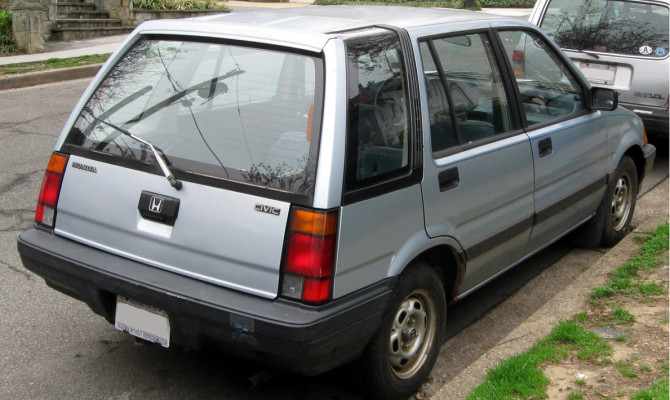
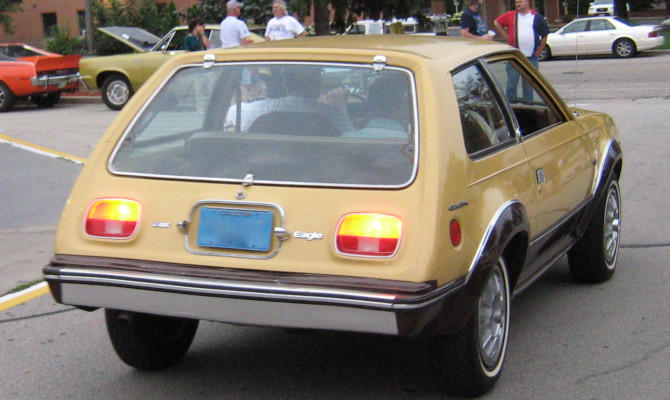
by Matt Lewis, Driveway
With winter still hitting some northern regions of the country, it seems only right to highlight some of the lesser-known AWD vehicles from our automotive past.
Completely by accident, this list starts with attractive vehicles, and it is downhill from there!
Toyota Celica GT-Four All-Trac Turbo
One of my favorite lesser-known AWD vehicles, the Toyota Celica GT-Four All-Trac Turbo, was not only attractive but packed a punch compared to the standard Celica seen in many high school parking lots. The intercooled turbo four-cylinder engine was capable of producing over 200 hp and 200 lb-ft. Plenty of power for helping you through some snow drifts on your way to work, or getting air over some crests in a rally stage.
Mitsubishi Galant VR-4
Sitting on top of the Galant line, this Evolution predecessor was limited in the USDM to only 3,000 units reaching our shore from 1991-1992. Any owner of the Galant VR-4 will proudly show you the production number plate on the dash. While the stock 237 hp from the factory is nothing to be ashamed of, the tuner favorite 4G63T engine is capable of making this an alarming sleeper car.
Honda Civic Wagovan AWD
I don’t know which I love more — the prospect of an AWD Civic (I’m a fan) or the fact that they named this the Wagovan. While you won’t be passing any other car on this list while driving one, you will get a fair number of people commenting, “I’ve never seen one of these.”
AMC Eagle Kammback
Any list of odd AWD vehicles is going to include the Eagle wagon. But if you want to get even weirder, here is the Kammback. Utilizing the aerodynamics derived from Wunibald Kamm, the Eagle Kammback was available for two whole years. AMC dropped the Kammback in 1983 due to slow sales after only 6,123 made it to the streets.
Toyota Previa S/C AWD
Okay, this is not a car, it’s a van but it’s undeniably cool. Toyota decided to produce a jellybean, then super charge it and push the power to all four wheels. The Roots-type supercharger provided 6psi through the air-to-air intercooler pushing the 2.4-litre four cylinder to an “impressive” 160 hp.
Pontiac 6000 STE AWD
For a whole two years Pontiac offered the 6000 STE that could turn all four wheels. The standard 3.1-litre V-6 had 135 hp. Not a crazy amount, but still enough to get you down the road in 1988. With hopes to compete with BMW and Audi, the Special Touring Edition fell short in multiple categories.
*Matt Lewis writes for Hagerty Insurance. Hagerty is the world’s leading specialist provider of classic car and boat insurance. Learn more at hagerty.ca.
by Grant Stoecker
Most 5- to 10-year-old cars are just used cars, destined to head steadily to the bottom of their depreciation curve as an intermediate stop on the way to their ultimate destination— the local pick-and-pull lot.
Here are five used cars that deserve a cushy spot in the Garage Mahal of a collector:
2009 Pontiac Solstice GXP coupe
Pontiac’s demise during GM’s bankruptcy was a sad story, and the loss of this fantastic sports car made it even more bitter. The Solstice roadster was an attractive car that suffered from terminal packaging problems. The Solstice coupe was drop-dead gorgeous and far more practical. Just 1,200 were built before GM did the equivalent of burning, pillaging and sowing salt in the field—they killed Pontiac, offed the Solstice and closed the Delaware plant in which it was built. Used coupes with normal miles have barely depreciated and low mileage cars are already appreciating.
2006 Chrysler Crossfire SRT6
The 2006 Crossfire SRT6 is undoubtedly the greatest lovechild of the affair between Chrysler and Mercedes-Benz in the early 2000s. While the standard Crossfire coupe and convertible where offered from 2004-2008, the SRT6 was only available in showrooms in 2005, and as a factory special order in 2006. This Chrysler/Benz mashup was essentially a Mercedes-Benz SLK32 AMG redressed as a hardtop coupe with breakneck performance, featuring a handcrafted AMG supercharged V-6 laying down 330 hp to the rear wheels. Hindsight is always 20/20, and the only regrettable decision in development of the car was to offer only the AMG signature automatic transmission, making it the only model in the Crossfire lineup not offered with a 5-speed manual. Fewer than 1,500 were produced, making this model quite rare.
2005-2011 Lotus Elise
While the Lotus Elise’s last model year technically was 2011, they still are being produced as a stopgap model until the 3rd generation model is released. Unfortunately, the Elise lost its smart airbag exemption stateside, meaning that the only Lotus available in North America is the all-too-luxurious Evora — it even has air-conditioning and power steering as standard equipment. On a Lotus! For those who still want to enjoy the ever-so-Spartan Elise, consider looking to the used car market. However, buyers might want to be wary of HPDE and track cars, as these have probably seen quite a bit of abuse — Elises with salvage titles are prevalent.
1999-2009 Honda S2000
Possibly the best enthusiast car produced under the Honda badge in the past decade, the S2000 served as a fitting tribute to the S-series roadsters of the 1960s. With its aggressive styling, a high-revving 4-cylinder engine producing 237 hp, an ultra-low center of gravity, and 50/50 weight distribution, an unmolested S2000 is bound to be a future collector car. However, due to the affordability of the S2000, many have suffered a cruel and all-too-usual punishment at the hands of the “Fast and Furious” generation. Serious collectors should look for the rarer Club Racer model, which saw limited production in 2007 only.
2012/2013 Ford Mustang Boss 302
This special edition of Ford’s ever-popular Mustang saw the return of the late ’60s and early ’70s Trans Am legend, the Boss 302. The Boss got its original name in the late ’60s when it was a skunk works project at Ford. Whenever asked what they were working on, members of the team simply responded “the boss’s car,” and the nomenclature stuck. The new generation features a retuned 5.0, putting out an additional 32 hp, and enough track day goodies to make any racing enthusiast giddy at even the slightest thought of it. In addition to the standard Boss, an additional Laguna Seca variant is available. The LS is a further upgrade with racecar parts, including a rear cross brace, and is limited to only 750 units per year. The Boss 302 was only produced for its scheduled two-year run, with just 4,000 models made each year, ensuring future collectability.
*Grant Stoecker writes for Hagerty Insurance. Hagerty is the world’s leading specialist provider of classic car and boat insurance. Learn more at hagerty.ca…
“These cars are the obscure and forgotten (but still oddly appealing) afterthoughts of the decade…”
The often-maligned 1970s produced plenty of truly memorable cars, from the Pontiac Trans Am to the Porsche 911 Turbo. These aren’t those cars. These cars are the obscure and forgotten (but still oddly appealing) afterthoughts of the decade. Here are five worth remembering:
- 1975-80 Chevrolet Monza– The Monza did a good job of hiding its Chevy Vega roots, although GM insiders still persist in calling it the “Italian Vega” because it cribbed so many styling cues from Ferrari. It was actually a very good-looking rear-wheel-drive sport coupe that was available with a variety of engines, including three V8s, a 262, 305 and 350. The latter two were only for California and high-altitude markets, but the 305 with 140hp was the one to have, with the other two engines making 110 and 120 hp. While more than 700,000 Monzas were built, very few seem to have survived.
- Opel GT– The Opel GT sported mini C3 Corvette styling courtesy of Chevy stylist Clare MacKichan. Even the instrument panels look similar. Power came from Opel’s optional 1.9-liter “high-cam” four-cylinder engine, with the smaller 1.1-liter standard but rarely seen in the U.S. Performance with the 1.9-liter was quite decent, with the car solidly outperforming cars like the MGB GT and the carbureted BMW 2002. Buick dealers were happy to have the car in the U.S., as it gave them a sportier product with which to lure young buyers into the showroom. It was the Datsun 240Z, however, that spelled the end of the Opel GT; it simply couldn’t compete in price or performance. Few people today remember the curious little mini-Corvette.
- 1970-78 Mazda RX-2– The RX-2 was Mazda’s first attempt at selling a rotary powered car in large volumes. It was an attractive little thing that did without so many of the odd styling gimmicks employed by Japanese cars of the day. The Rotary was powerful and torquey and could surprise its share of V-8 powered Detroit iron at a stop light, but at the end of the day, the rotary was as thirsty as a Detroit V-8, negating any advantage there. Still, the RX-2 is technically interesting and rare today in a climate of growing collector interest in early Japanese cars.
- 1973-75 Pontiac Grand Am Colonnade coupe– The first car to carry the Grand Am name (which was an amalgam of Grand Prix and Trans Am) was a big, thirsty, traditional American personal luxury car with a few Euro touches in the seating department and in the real wood interior accents. It also had a soft Enduro nose that gave it a unique and sporty look compared to its more traditional A-body cousins, the Buick Century and Olds Cutlass Supreme. The ’73 model was the swan song of real horsepower with 400 and 455 engines available that both made well over 200hp. There was even a rather unpopular manual transmission option. The Oil Crisis put sales into a tail spin, but the unique sight of a Grand Am today can give still another reason to miss Pontiac.
- 1981-83 AMC Eagle SX/4– The Eagle SX/4 was based on the AMC Spirit, which was essentially a masterfully restyled Gremlin. And while the Audi Quattro coupé generally gets all the credit for marrying all-wheel drive to a two-door car with sporting pretensions (the Jensen FF actually did it first in 1967), the little Eagle SX/4 appeared at right around the same time the Quattro was introduced in Europe. Interestingly, it was available with a five-speed manual transmission. Cynics might poke fun at the Eagle SX/4’s high ground clearance and dismiss it as a “Joe Dirt” Quattro, but the little Eagle was a particularly impressive car given the fact that AMC’s R&D budget was a fraction of what the Volkswagen/Audi group had to play with.
Rob Sass is the vice-president of content for Hagerty Insurance. Hagerty is the world’s leading specialist provider of classic car and boat insurance. Learn more at hagerty.ca and you can email rsass [at] hagerty [dot] com
Pictures:
Chevrolet_Monza: Chevrolet Monza
Eagle_sx4: AMC Eagle SX/4
Mazda_RX-2 René: 1971 Mazda RX-2 (photo courtesy of René)
Opel_GT Thomas doerfer: Opel GT (photo courtesy of Thomas Doerfer)
Pontiac_Grand_Am: Pontiac Grand Am
Finding five used cars under ten grand doesn’t sound like too big a challenge, until a “for a college student” stipulation is added.
In my mind, this adds a few requirements as the car has to be, easy on fuel, reliable, easy to park, good on gas, thrives on abuse, room for friends, room for a bike and camping gear, super fuel efficient … and look good!
So, bearing in mind the last requirement is a highly subjective one and ignoring the (no brainer) most popular car in Canada (Honda Civic), here are five vehicle suggestions – in no particular order:
Pontiac Vibe (2010 or older): Although the Pontiac Vibe looks different, you also know this compact 4-door hatchback as the Toyota Matrix. A joint (GM/Toyota) production venture ended with the 2010 model year, as did the Pontiac brand. The resale value of a Vibe is generally lower than a same year/condition Matrix, or conversely, you may be able to buy a newer/lower mileage Vibe.
The ’09 Vibe was a second generation redesign and a slightly bigger model that came in front-drive and all-wheel-drive editions, and in base and GT trim levels. The base engine is a gas-miser 1.8-litre (132 horsepower) and a 2.4-litre (158 horsepower) engine comes in the AWD and GT models.
Fuel consumption (1.8L/FWD): 8.0/6.2 L/100 km (city/highway)
Fuel consumption (2.4L/AWD): 10.3/7.8 L/100 km (city/highway)
Honda Fit (2010 or older): The Honda Fit is a small, but taller, 4-door hatchback that was introduced for the 2007 model year and came in DX, LX and Sport trim levels. Its seats can be reconfigured in an amazing variety of ways and there’s even a couch/bed recliner position.
The 2009 model was a second generation redesign with a more powerful 117 horsepower (up from 109-horsepower) 1.5-litre engine that’s mated to either a five-speed manual transmission or optional five-speed automatic. In the Sport edition, this automatic also comes with paddle shift gear selection at the steering wheel.
Fuel consumption (1.5L/FWD): 7.1/5.5 L/100 km (city/highway)
Jeep Patriot (2010 or older): The Patriot could also be called “Jeep Light”, as it’s an affordable, compact yet capable SUV/wagon that’s surprisingly fuel-efficient. Available in both front-drive and four-wheel-drive configurations, Jeep launched Patriot for the 2007 model year and it’s a good match of an active lifestyle young person that enjoys the outdoors.
Patriot came in Sport, North and Limited trim levels and the base engine is a 2.0-litre that can produce 158-horsepower and 2.4-litre that can produce 172 horsepower is the upgrade. The transmissions offered were a 5-speed manual transmission or a fuel-efficient CVT (continuously variable transmission) automatic.
If serious 4-wheeling is contemplated look for models with a trail-rated Freedom II off-road package that adds protective skid plates, etc. The down-side is increased weight and higher fuel consumption.
Fuel consumption (2.0L/FWD): 8.9/6.9 L/100 km (city/highway)
Fuel consumption (2.4L/4WD): 9.9/8.2 L/100 km (city/highway)
Nissan Versa (2011 or older): The Nissan Versa may look small on the outside, but this four-door sedan or hatchback has an amazing amount of space on the inside. The extra head and leg room provided make it a very good match for a taller or bigger than average young person.
Versa offers seating for four (squeeze five) full-sized adults and extra-large rear passenger doors also make getting in or out easier. The lower-priced sedan comes with a 1.6-litre (107-horsepower) engine and a 5-speed manual or 4-speed automatic. The hatchback comes with a 1.8-litre (122-horsepower) engine and a 6-speed manual, 4-speed automatic or a CVT automatic.
Prior to 2010, a base Versa didn’t come with ABS (anti-lock braking system), and electronic stability control wasn’t even offered as an option. Its electronic-assist steering has an extra-light feel and it can turn on a (10.4 m) dime, making Versa an easy vehicle to park.
Fuel consumption (1.6L/FWD): 7.7/5.8 L/100 km (city/highway – 5 Manual)
Fuel consumption (1.8L/FWD): 8.5/6.2 L/100 km (city/highway – 4 Automatic)
Fuel consumption (1.8L/FWD): 7.3/5.8 L/100 km (city/highway – CVT)
Mazda3 (2009 or older): The first generation Mazda3 (2004 to 2009) set a new performance standard in the economy car segment. Sold as a four-door sedan or a (sportier) five-door hatchback, the Mazda3 has been a huge sales success in Canada.
The four-door sedan editions of this Mazda3 come with (148-horsepower) 2.0-litre engine and in GX and GS trim levels. Sedan GT and (hatchback) Mazda3 Sport come in GS and GT trim levels and with a (156-horsepower) 2.3-litre engine, with more torque at lower engine speeds.
A height adjustable, good supporting driver’s seat plus a standard tilt and telescopic steering column make the Mazda3’s driving position particularly praiseworthy. It definitely offers the best driving experience, but popularity also makes Mazda3 the priciest pick of this group.
Fuel consumption (2.0L/FWD): 8.4/6.1 L/100 km (city/highway)
Fuel consumption (2.3L/FWD): 9.5/6.8 L/100 km (city/highway)
**********
Reviewing the attributes of these car leads me to suggest there’s at least one suitable for anybody on a budget.
Automotive designers have been cribbing from each other since the dawn of the automotive era.
Often it’s less obvious to borrow from far away than from your own backyard. Witness the countless European-inspired American cars we’ve seen over the years (like the 1989-97 Ford Thunderbird, a virtual copy of the 1977 BMW 630 CSi). Europe has been known to return the favour on occasion, too, as anyone who has ever seen an Opel GT (which looks for all the world like a 2/3-scale ’68 Corvette) can attest.
The cars on this list dispense with any of that “hands across the water” nonsense. They couldn’t have come from anywhere else – they’re as proudly North American as it gets:
As over-the-top as anything got in the golden age of the American muscle car, the wild, aerodynamic nose cone and 11-story rear wing were designed to ensure NASCAR domination back in the days when the race cars actually had to resemble something you could go into a showroom and buy. Add the massively powerful and virtually handmade 426-ci hemi V-8, and you’ve got another “only in America” classic.
Jeep CJ-5
The CJ-5 was actually a variant of the Korean War-era military Jeep. Far more suited to civilian use than the WWII-era Jeep, the CJ-5 was a hot seller for American Motors, which took over Jeep’s parentage from the old Kaiser Automotive Group. Its familiar face is in every “greatest generation” newsreel and our favorite WWII/Korea movies from “Patton” to “M*A*S*H.” Few things say “America” like a Jeep CJ.
1959 Cadillac Eldorado Seville
Not only was the name of this car over-the-top (combining two names that would do just fine on their own), but it marked the high-water point for the tailfin fad inspired by the WWII Lockheed P-38 Lightning fighter plane. These were the Empire State Building of tailfins, with twin rocket-like tail lamps embedded in them. Any ’59 Caddy is a simply stunning work of art from an era of unmatched American optimism.
The Goat (which celebrates its 50th anniversary next year) can reasonably lay claim to starting the muscle car craze. The idea was to stuff a gigantic 389-ci V-8 into the smallest body possible (the Pontiac Le Mans). And although the name was a direct theft from Ferrari, nothing else about the GTO could have come from anywhere else but America. With Pontiac gone for good, another revival seems unlikely. May it rest in peace.
Ford F-Series: America invented the pickup truck with the 1925 Ford Model T pickup. And although everyone from Toyota to VW has dabbled in them, the center of the pickup universe will always be in the U.S. Perhaps the most quintessentially American pickup is the 1948-52 Ford F-Series.
Rob Sass is the vice-president of content for Hagerty Insurance. Hagerty is the world’s leading specialist provider of classic car and boat insurance. Learn more at hagerty.ca and you can email rsass [at] hagerty [dot] com.
Station wagons are officially and endangered species in North America.
Richard Nixon was president when the last really cool one was built in America. A quick look at the cars on this list might make you re-think any preconceived notions that wagons were all “Mom Mobiles” for the pre-minivan generation.
1955-57 Chevrolet Nomad
The iconic Tri-Five Chevy, built from 1955-1957, was likely the post-war high-water mark for Chevrolet. It came in myriad body styles and was available with the first version of Chevrolet’s legendary small-block V-8. The two-door Nomad wagon gives even the convertible a serious run for its money in the cool department.
The 1950s were littered with cool station wagons with over-the-top styling. Our vote goes for the ’59 Pontiac Safari. That was the model year in which tail fins reached their absurd apex. The ’59 Safari actually had two sets of fins on the top and the bottom of the rear fenders, making it look like a Redstone ballistic missile – which was probably not an accident.
1964-65 Chevrolet Chevelle
Two-door wagons are very impractical to the point of defeating the purpose of having a wagon in the first place, but they look cool. We love the first-generation Chevelle two-door wagon for its handy size, great looks and the fact that all of the performance parts from the two-door SS coupe will fit on the wagon, making it a great sleeper muscle car.
1968-72 Oldsmobile Vista Cruiser
The Vista Cruiser and the Ford Country Squire are the cars that immediately come to mind when referring to the “back backseat,” and it was probably in one of these wagons where the classic slow-burn phrase “Don’t make me come back there” was first uttered by an agitated father. The Olds gets the nod in terms of cool, simply because we love the glass roof and GM’s spot-on styling work.
1971-73 Volvo 1800ES
Volvo of the 1960s and ‘70s wasn’t exactly a company synonymous with high style. Frumpy but practical 544s, Amazons and brick-like 240s were the stereotypical Volvos of the day. But the P1800 coupe was gorgeous, and for a few brief model years it was available as a very pretty two-door sports wagon. Nicknamed “Cinderella’s Coffin” by some for their long, flat roof lines and generous glass, these wagons are among the few truly collectible Volvos — and they run virtually forever.
Rob Sass is the vice-president of content for Hagerty Insurance. Hagerty is the world’s leading specialist provider of classic car and boat insurance. Learn more at hagerty.ca and you can email rsass [at] hagerty [dot] com
Baby boomers are in full nostalgia mode as they contemplate their lost youth. (more…)
A good friend of mine owns a number of Healeys in various states of (dis)repair and one or two roadworthy examples. Keep hoping he’ll gift me one that’s closer to restoration…
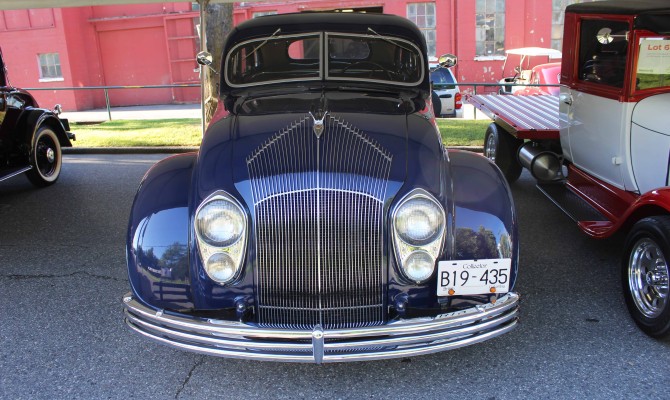
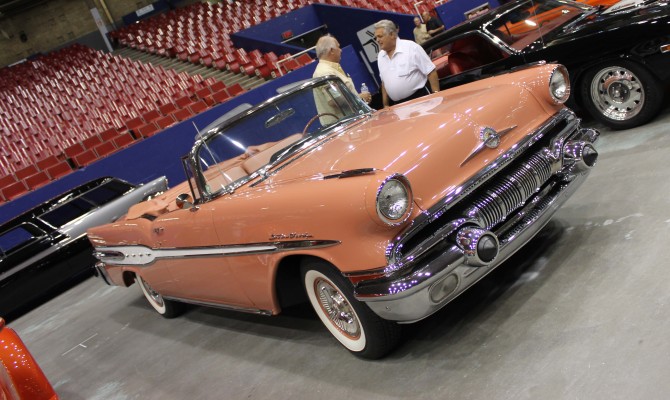
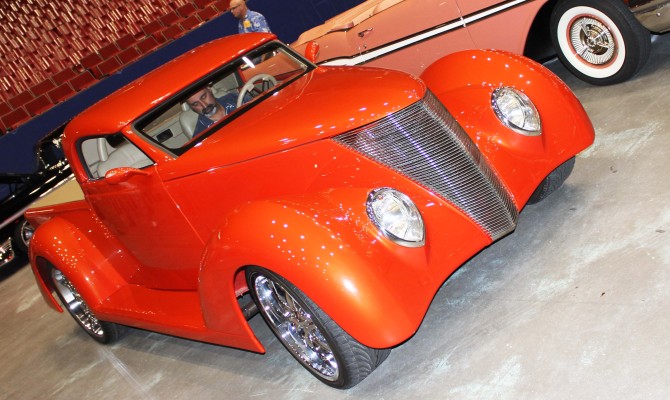
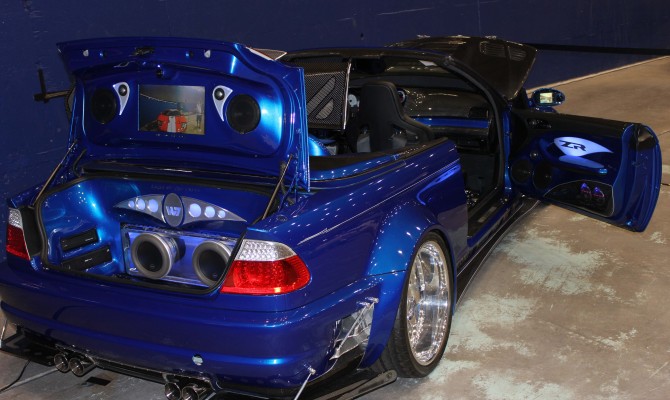
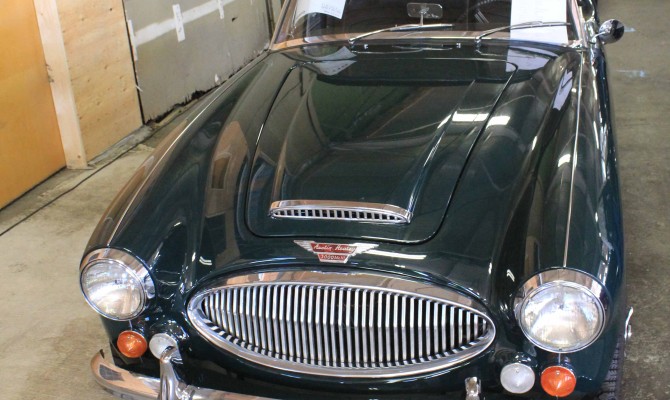
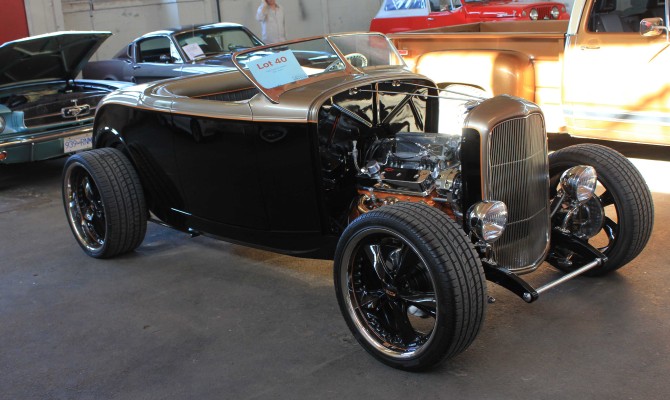
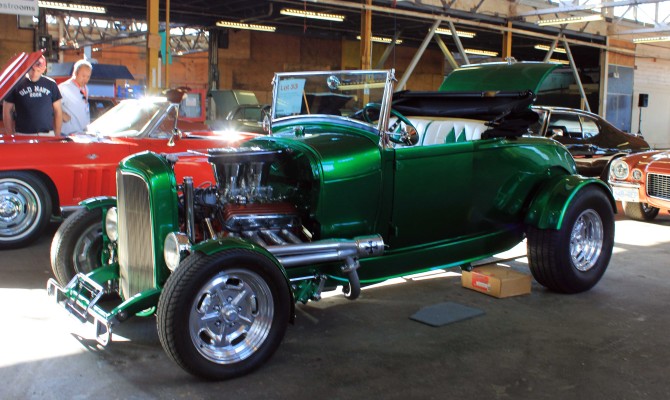
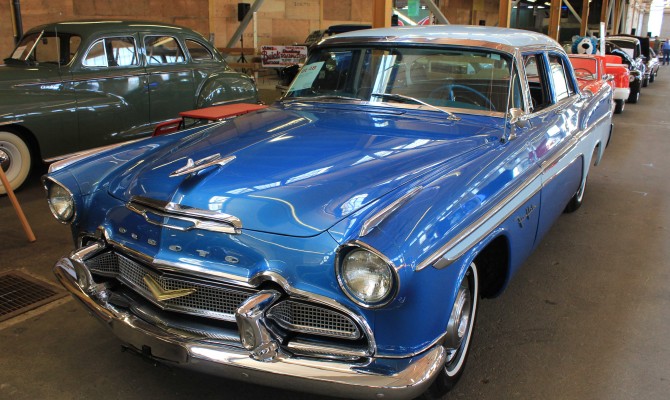
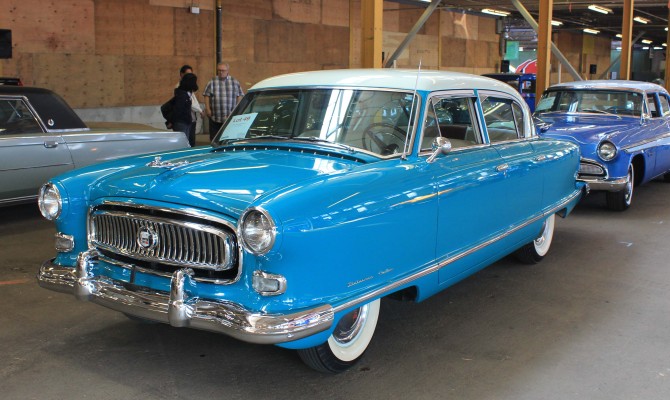
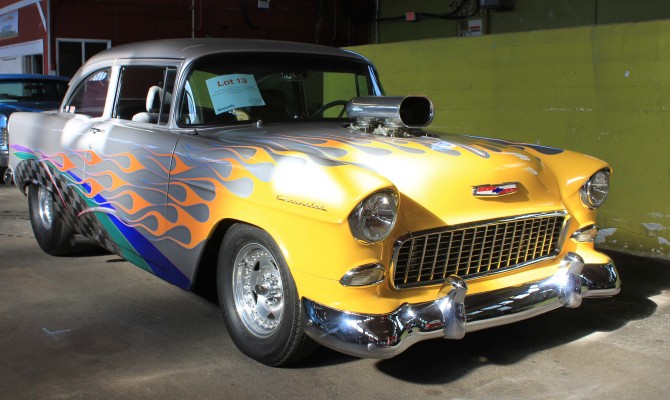
You didn’t need a bidder’s paddle to enjoy the excitement of the second annual Vancouver Collector Car Show & Auction.
More than 650 collector and classic autos descended upon the PNE Fairgrounds this past weekend and another 150 went on the block, many surpassing their reserve bid limits. Speed TV’s Steve Magnante was on hand to move the auction along but the cars were the true stars.
Yours truly focussed on the beauties that were for sale, as many of the gems displayed by the car clubs represented at the show will undoubtedly show up in Driveway over the summer season of show and shines.
Here are 10 that caught my eye (photo gallery above)…
1955 Chevrolet 2-door Post Sedan:
For those who like to make a visual a well as audible impression. No chance of cruising quietly around the neighborhood in this loudly painted Chev with the big block 468 CID V8 – 650 hp engine, which is now capable of pushing out 720 horses and a promised 825 at the next tuneup.
1952 Nash:
I’ve always like the funky look of these cars. They are positively odd but I love’em. There was another example featuring a matching tow trailer.
1956 Desoto Fireflite Hemi:
This Desoto is still powered by its original 330 CID Hemi V8! – A marque long gone from production but vividly remembered in the minds of collectors.
1928 Ford Modified roadster:
Handsome beast.This 1928 Model A Roadster Custom features a 302 engine from a 1978 Lincoln and its mated to 1978 C4 auto transmission.
1932 Ford Roadster:
Likewise the looks of this Ford Roadster, which has a 350 Chevy Ramjet engine and auto tranny. Built from ground up with brand new parts by Kaotic Customs in Langley.
1967 Austin Healey 3000 Mk 3:
The last year of production for the Austin-Healey 3000, a very popular British sports car built from 1959. A good friend of mine owns a number of Healeys in various states of (dis)repair and one or two roadworthy examples. Keep hoping he’ll gift me one that’s closer to restoration.
1934 Chrysler Airflow:
It’s a piece of art. Check out the unusual grille. It has less than 53,000 miles on the clock and was discovered in a North West garage back in the 1980s.
1940 Ford Custom Pickup:
Not my cup of tea but I may be in the minority judging by the swarming behaviour of the crowd this weekend.
1957 Pontiac Convertible:
Really don’t like the coral colour but love everything else about it.
It’s a 1957 Star Chief Convertible with a continental kit.
2002 BMW M3:
It’s amusicmobile judging by the amazing sound system. But it’s no slouch on the non-musical performance front. It has a 3.2L turbo – 525 HP engine.
**********
To view all the cars offered and what they sold for at the auction, please visit VancouverCollectorCars.com
Some new cars sneak into the world under the radar with little baggage in the form of expectations (realistic or otherwise).
Others are so heavily touted that even the best can sink under the weight of unrealistic pressures. Here are some that, in addition to being under the microscope when introduced, suffered from many glitches.
MINIVAN
1990-93 Pontiac Trans Sport
GM perceived an unexploited niche for a minivan with some style, much like the European Renault Espace.
The concept car was brilliant, with gullwing doors and a glass roof. Unfortunately, none of these features translated into the production model, whose awkward profile resembled a Black and Decker Dustbuster mini vacuum.
The nickname “Dustbuster” stuck, and sales were modest. Buyers found them hard to see out of because of the huge distance between the steering wheel and the windshield.
SMALL CAR
1971-77 Chevrolet Vega
The Vega was supposed to be the small car that sent the new wave of Japanese imports back across the Pacific.
Instead, it pushed a giant wave of buyers into Toyota and Datsun showrooms. The aluminum engine, which was prone to overheating and oil burning, and the hideously rust-prone bodies were often just the tip of the misery iceberg for Vega owners.
Even the air in the tires seemed substandard.
LUXURY CAR
GM struggled to maintain a sense of traditional luxury under the weight of the first Corporate Average Fuel Economy (CAFE) regulations.
And while the idea of a V-8 engine that turned off cylinders when they weren’t needed had promise that would eventually be realized, the technology of the day wasn’t up to the task and the feeling of the cylinders shutting off and on was perceptible to the point of being nausea-inducing.
Cadillac introduced at least 13 new computer chips for the cylinder deactivation control system before giving up.
SPORTS CAR
1972-75 Jensen-Healey
The Jensen-Healey was designed to be the successor to the much-loved Austin-Healey 3000, with input from the legendary Donald Healey.
Unfortunately, where the earlier car had a lovely and curvaceous style to it, the J-H was perceived as bland and derivative. Also problematic was the new and untested Lotus twin-cam engine. Broken timing belts, oil leaks and low oil pressure issues ensured that warranty claims added up quickly and the Jensen-Healey was gone after just four model years.
SUPERCAR
1989-93 Vector W8
Promoted heavily as America’s answer to supercars like the Lamborghini Diablo, the Vector was underfunded, underdeveloped and (some said) amateurishly styled.
Tennis star Andre Agassi was an early and unhappy customer when his car failed spectacularly on his first day of ownership, by some accounts setting his garden on fire. Accusations and legal threats flew both ways, and in the end, just 17 cars were built before the whole venture collapsed.
The original price was $455,000.
*Rob Sass is the vice-president of content for Hagerty Insurance. Hagerty is the world’s leading specialist provider of classic car and boat insurance. Learn more at hagerty.ca and you can email rsass [at] hagerty [dot] com
Recent Comments
- { Enjoyed your Forest of Bowland in the BMW X5M, particularly the photo of the BMW in front of the main part of Stonyhurst College where... }
- { Bantam designed the Jeep, not Willy's or Ford. The American military gave the original Bantam prototype to Willys and Ford to copy. There is plenty... }
- { All Escalades come with a 6.2-lilter V8 engine that produces 420 horsepower. A six-speed automatic is the only transmission offered and drives the rear wheels.... }
- { Alexandra is an excellent journalist. }
Popular Posts
- Journey to a ‘Sparkling’ Luxury Okanagan Resort “Four lucky readers will put a Dodge Journey’s weekend-...
- The Need For Speed: Hike Those Highway Limits More than half of those polled believe the province sho...
- Drives-U-Crazy… Erratic drivers. An early morning drive from Kelowna to Vancouver is nor...
- Readers Respond: The Pros and Cons of Increasing B.C. Speed Limits Increasing the speed limits will only increase risk to...
- Honda CR-V Review: The Compact Crossover To Get Things Done The CRV is a very stylish and aerodynamic crossover veh...


